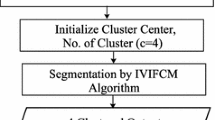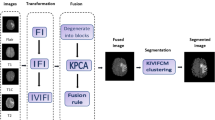Abstract
The early and accurate detection of brain tumors is key to improve the quality of life and the survival of cancer patients. Magnetic resonance imaging (MRI) is a widely used imaging technique to assess these tumors, but the large amount of data produced by MRI prevents manual segmentation in a reasonable time, limiting the use of precise quantitative measurements in the clinical practice. Consequently, automatic and reliable segmentation methods are required. However, the large spatial and structural variability among brain tumors make automatic segmentation a challenging problem. In this contribution, we present a new model of segmentation of brain magnetic resonance images. In order to obtain the region of interest, we propose a hybrid approach that carries out both fuzzy c-mean algorithm and multiobjective optimization taking into account both compactness and separation in the clusters with the purpose of improving the cluster center detection and speed up the convergence time. This new segmentation approach is a key component of the proposed magnetic resonance image-based classification system for brain tumors. Experimental results are presented to demonstrate the effectiveness and efficiency of the proposed approach using the DICOM MRI database.






Similar content being viewed by others
References
Agrawal S, Panda R, Dora L (2014) A study on fuzzy clustering for magnetic resonance brain image segmentation using soft computing approaches. Appl Soft Comput 24(Supplement C):522–533
Ananthi VP, Balasubramaniam P, Kalaiselvi T (2016) A new fuzzy clustering algorithm for the segmentation of brain tumor. Soft Comput 20(12):4859–4879
Atanassov KT (1986) Intuitionistic fuzzy sets. Fuzzy Sets Syst 20(1):87–96
Bakhshali MA (2017) Segmentation and enhancement of brain mr images using fuzzy clustering based on information theory. Soft Comput 21(22):6633–6640
Bauer S, Wiest R, Nolte1 L, Reyes M (2013) A survey of mri-based medical image analysis for brain tumor studies. Phys Med Biol 58(13):R97–R129
Bezdek J, Ehrlich R, Full W (1984) Fcm: The fuzzy c-means clustering algorithm. Comput Geosci 10(2–3):191–203
Bong C, Mandava R (2011) Multi-objective nature-inspired clustering and classification techniques for image segmentation. Appl Soft Comput 11(4):3271–3282
Coello C (2000) Handling preferences in evolutionary multiobjective optimization: a survey. IEEE Evol Comput 1:30–37
De Oliveira J, Machado A, Chavez G, Lopes A, Deserno T, Arajo A (2010) Mammosys: a content-based image retrieval system using breast density patterns. Comput Med Imaging Graph 99:289–297
DeAngelis LM (2001) Brain tumors. N Engl J Med 344(2):114–123
Deb K, Beyer H (2001) Self-adaptive genetic algorithms with simulated binary crossover. Evol Comput 9(2):197–221
Deb K, Pratap A, Agarwal S, Meyarivan T (2002) A fast and elitist multiobjective genetic algorithm: Nsga-ii. IEEE Trans Evol Comput 6(2):182–197
Dou W, Wu Q, Chen Y, Ruan S, Constans J (2005) Fuzzy modelling of different tumorous cerebral tissues on mri images based on fusion of feature information. In: Engineering in Medicine and Biology Society, 2005, pp. 3104–3107
Drevelegas A, Papanikolaou N (2011) Imaging modalities in brain tumors. Springer, Berlin, pp 13–33
Dunn JC (1973) A fuzzy relative of the isodata process and its use in detecting compact well-separated clusters. J Cybern 3(3):32–57
El-Dahshan ESA, Mohsen HM, Revett K, Salem ABM (2014) Computer-aided diagnosis of human brain tumor through mri: A survey and a new algorithm. Expert Syst Appl 41(11):5526–5545
Emre C, Kingravi H, Vela P (2013) A comparative study of efficient initialization methods for the k-means clustering algorithm. Expert Syst Appl 40(1):200–210
Friston K, Chu C, Mourao-Miranda J, Hulme O, Rees G, Penny W, Ashburner J (2008) Bayesian decoding of brain images. Neuroimage 39(1):181–205
Georgiadis P, Cavouras D, Kalatzis I, Daskalakis A, Kagadis G, Sifaki K, Malamas M, Nikiforidis G, Solomou E (2008) Improving brain tumor characterization on mri by probabilistic neural networks and non-linear transformation of textural features. Comput Methods Programs Biomed 89(1):24–32
Gordillo N, Montseny E, Sobrevilla P (2013) State of the art survey on mri brain tumor segmentation. Magn Reson Imaging 31(8):1426–1438
Huang CW, Lin KP, Wu MC, Hung KC, Liu GS, Jen CH (2015) Intuitionistic fuzzy c-means clustering algorithm with neighborhood attraction in segmenting medical image. Soft Comput 19(2):459–470
Kass M, Witkin A, Terzopoulos D (1988) Snakes: active contour models. Int J Comput Vis 1(4):321–331
Kinani JMV, Rosales-Silva AJ, Gallegos-Funes FJ, Arellano A (2014) Fuzzy c-means applied to mri images for an automatic lesion detection using image enhancement and constrained clustering. In: 2014 4th International conference on image processing theory, tools and applications (IPTA), pp. 1–7 . https://doi.org/10.1109/IPTA.2014.7001987
Kumar D, Nguyen T, Gauthier S, Raj A (2012) Bayesian algorithm using spatial priors for multiexponential t(2) relaxometry from multiecho spin echo MRI. Magn Reson Med 12(4):1536–1543
Maulik U (2009) Medical image segmentation using genetic algorithms. IEEE Trans Inf Technol Biomed 13(2):166–173
Meschino G, Comas D, Vallarin V, Scandurra A, Passoni L (2014) Automatic design of interpretable fuzzy predicate systems for clustering using self-organizing maps. Neurocomputing 147(5):47–59
Mukhopadhyay A, Maulik U, Bandyopadhyay S (2011) Gene expression data analysis using multiobjective clustering improved with svm based ensemble. Silico Biol 11(1–2):19–27
Pham D, Prince J (1999) Adaptive fuzzy segmentation of magnetic resonance images. IEEE Trans Med Imaging 18(9):737–752
Phillips W, Velthuizen R, Phuphanich S, Hall L, Clarke L, Silbiger M (1995) Application of fuzzy c-means segmentation technique for tissue differentiation in mr images of a hemorrhagic glioblastoma multiforme. Magn Reson Imaging 13(2):277–290
Rosas-Romero R, Rodriguez-Asomoza J (2003) 4-d active contour snake model for object representation from medical images. In: Proceedings of the 25th annual international conference of the IEEE engineering in medicine and biology society (IEEE Cat. No.03CH37439), vol. 1, pp. 717–719 Vol 1
Schad LR, Blml S, Zuna I (1993) Ix. mr tissue characterization of intracranial tumors by means of texture analysis. Magn Reson Imaging 11(6):889–896
Shattuck D, Leahy R (2002) Brainsuite: an automated cortical surface identification tool. Med Image Anal 6(2):129–142
Somasundaram K, Kalaiselvi T (2011) Automatic brain extraction methods for t1 magnetic resonance images using region labeling and morphological operations. Comput Biol Med 41(8):716–725
Stephen T, Wong C, Huang H (1996) Design methods and architectural issue and integrated medical image data base systems. Comput Med Imaging Graph 20(4):285–299
Ureña R, Chiclana F, Fujita H, Herrera-Viedma E (2015) Confidence-consistency driven group decision making approach with incomplete reciprocal intuitionistic preference relations. Knowl Based Syst 89:86–96
Ureña R, Martínez-Cañada P, Gómez-López JM, Morillas C, Pelayo F (2012) Real-time tone mapping on gpu and fpga. EURASIP Journal on Image and Video Processing (1)
Ureña R, Morillas C, Pelayo FJ (2013) Real-time bio-inspired contrast enhancement on gpu. Neurocomputing 121(Supplement C):40–52
Vaidyanathan M, Clarke L, Velthuizen R, Phuphanich S, Bensaid A, Hall L, Bezdek J, Greenberg H, Trotti A, Silbiger M (1995) Comparison of supervised mri segmentation methods for tumor volume determination during therapy. Magn Reson Imaging 13(5):719–728
Vescan A, Grosan C, Pop HF (2008) Evolutionary algorithms for the component selection problem. In: 2008 19th International workshop on database and expert systems applications, pp. 509–513 . https://doi.org/10.1109/DEXA.2008.138
Wang XY, Bu J (2010) A fast and robust image segmentation using fcm with spatial information. Digit Signal Process 20(4):1173–1182
Wells W, Grimson W, Kikinis R, Jolesz F (1996) Adaptive segmentation of mri data. IEEE Trans Med Imaging 15(4):429–442
Xie X, Beni G (1991) A validity measure for fuzzy clustering. IEEE Trans Pattern Anal Mach Intell 13(8):841–847
Xu C, Pham D, Rettmann M, Yu D, Prince J (1999) Reconstruction of the human cerebral cortex from magnetic resonance images. IEEE Trans Med Imaging 18(6):467–480
Yang X, Fei B (2011) A multiscale and multiblock fuzzy c-means classification method for brain mr images. Med Phys 38(6):2879–2891
Yang Y, Chen JX, Kim W (2003) Gene expression clustering and 3d visualization. Comput Sci Eng 5(5):37–43
Yu J, Cheng Q, Huang H (2004) Analysis of the weighting exponent in the fcm. IEEE Trans Syst Man Cybern Part B (Cybern) 34(1):634–639
Acknowledgements
This research is supported by PhD scholarship subprogram SENACYT-IFARHU (Secretaría Nacional de Ciencia, Tecnología e Innovación y el Instituto para la Formación y Aprovechamiento de Recursos Humanos), CN2070-2013-052, Panamá, Republic of Panama, the scholarship program COOPEN-Erasmus Mundus external cooperation windows: Polytechnic University of Valencia, Spain, the Autonomous University of Chiriqui, David, Panama. UNACHI (Universidad Autónoma de Chiriquí, David, Panamá) and FEDER funds (Grant number TIN2016-75850-R) and H2020-MSCA-IF Funds (Project DeciTrustNET ID: 746398). The authors would like to thank Ph.D. Del Fresno Mariana.
Author information
Authors and Affiliations
Corresponding author
Ethics declarations
Conflict of interest
This study was funded by SENACYT-IFARHU (Grant number CN2070-2013-052) and FEDER funds (Grant number TIN2016-75850-R) and H2020-MSCA-IF Funds (Project DeciTrustNET ID: 746398). Author Iván Ariel Rodríguez Méndez declares he has no conflict of interest. Author Raquel Ureña declares she has no conflict of interest. Author Enrique Herrera-Viedma declares he has no conflict of interest. This article does not contain any studies with human participants performed by any of the authors.
Additional information
Communicated by V. Loia.
Publisher's Note
Springer Nature remains neutral with regard to jurisdictional claims in published maps and institutional affiliations.
Rights and permissions
About this article
Cite this article
Rodríguez-Méndez, I.A., Ureña, R. & Herrera-Viedma, E. Fuzzy clustering approach for brain tumor tissue segmentation in magnetic resonance images. Soft Comput 23, 10105–10117 (2019). https://doi.org/10.1007/s00500-018-3565-3
Published:
Issue Date:
DOI: https://doi.org/10.1007/s00500-018-3565-3




